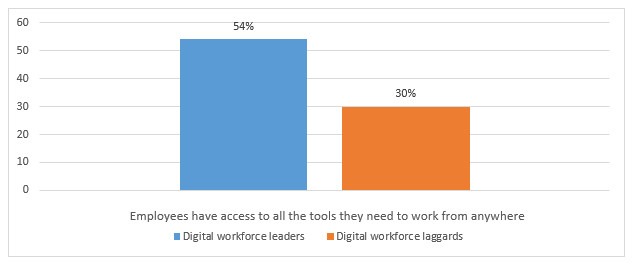Major Finding Three: While nearly two-thirds say managers get the technology and tools they need to manage remote workforces, companies are failing to use the tools necessary to support their digital workforces.
- Less than half (46%) give employees access to all the tools they need to work from anywhere.
- Just 22% have the smart tools they need to help make employees more efficient and focus on value-added work.
- Only 8% have the proper systems in place to help determine remote employee engagement and experience.
- Just over a quarter (27%) of managers are less certain their direct reports are meeting work expectations.
More than three-quarters indicate it is important to give employees access to the tools they need from anywhere.
We asked respondents what they believe are the three most important characteristics of the “digital workforce.” In today’s digital era, it is understandable that most equate the digital workforce with “employees who have access to all of the tools they need to work from anywhere” (77%). But having access to these tools is just part of the equation; employees must also be able to efficiently use them.
Fifty-eight percent say it is important that employees efficiently communicate with computer technologies. Fewer, however, think it is important that employees have the smart tools in place so they can more efficiently focus on value-added work (37%).
Just 10% think an important characteristic of the digital workforce is that a “considerable” portion of employees work remotely, indicating that remote work is only a small portion of being a digital workforce. That is, having the proper tools in place for remote work is more important than actually having remote workers. It is the capability that is crucial.
But Digital Leaders are Different
In analyzing our data, we were able to segment respondents into two groups: digital workforce leaders and digital workforce laggards. Leaders are those who “strongly agree” and “agree” that their organization’s managers have the tools, technology, education and training required to manage their remote workforce well.
Our research found that those we define as “digital workforce leaders” give their employees access to all the tools they need to work from anywhere more often. They are in fact more likely (54%) than digital workforce laggards (30%) to recognize that employees need the proper tools and to follow through on delivering those tools to them.
This goes beyond a computer. Besides a computer, today’s digital employees need access to file sharing tools (like Google or Dropbox), messaging services (like Skype), virtual group conferencing tools (like Zoom or Microsoft Teams) and more. The best managers—the digital workforce leaders—recognize this and take the necessary steps to ensure that their employees have the tools they need to be both productive and engaged.

Digital tools play an important role in effective management in any environment—including the traditional brick and mortar environment. However, in virtual and hybrid environments, which are rapidly becoming the norm, digital tools are more critical than ever before for effectively supporting your workforce. Our research indicates that there is room to grow for many organizations in providing employees with access to the tools they need—and the training to support their effective use.
In our next post, we take a look at our fourth major finding: organizations struggling to manage remote workforces.



